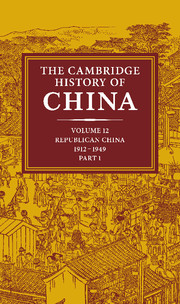Book contents
- Frontmatter
- 1 Introduction: Maritime and continental in China's history
- 2 Economic trends, 1912–49
- 3 The foreign presence in China
- 4 Politics in the aftermath of revolution: the era of Yuan Shih-k'ai, 1912–16
- 5 A constitutional republic: the Peking government, 1916–28
- 6 The warlord era: politics and militarism under the Peking government, 1916–28
- 7 Intellectual change: from the Reform movement to the May Fourth movement, 1895–1920
- 8 Themes in intellectual history: May Fourth and after
- 9 Literary trends I: the quest for modernity, 1895–1927
- 10 The Chinese Communist Movement to 1927
- 11 The Nationalist Revolution: from Canton to Nanking, 1923–28
- 12 The Chinese bourgeoisie, 1911–37
- Bibliographical essay
- Bibliography
- Index
- Republican China – physical features
- References
11 - The Nationalist Revolution: from Canton to Nanking, 1923–28
Published online by Cambridge University Press: 28 March 2008
- Frontmatter
- 1 Introduction: Maritime and continental in China's history
- 2 Economic trends, 1912–49
- 3 The foreign presence in China
- 4 Politics in the aftermath of revolution: the era of Yuan Shih-k'ai, 1912–16
- 5 A constitutional republic: the Peking government, 1916–28
- 6 The warlord era: politics and militarism under the Peking government, 1916–28
- 7 Intellectual change: from the Reform movement to the May Fourth movement, 1895–1920
- 8 Themes in intellectual history: May Fourth and after
- 9 Literary trends I: the quest for modernity, 1895–1927
- 10 The Chinese Communist Movement to 1927
- 11 The Nationalist Revolution: from Canton to Nanking, 1923–28
- 12 The Chinese bourgeoisie, 1911–37
- Bibliographical essay
- Bibliography
- Index
- Republican China – physical features
- References
Summary
CREATING A REVOLUTIONARY MOVEMENT
The Nationalist Revolution of the 1920s, one of the most interesting episodes in modern Chinese history, succeeded because of a remarkable mobilization of human energy and material resources in the service of patriotic and revolutionary goals. An organizational phase lasted from late 1923 until mid 1926 during which time a group of determined Chinese, starting with very little, created a revolutionary movement aimed at uniting the country, overcoming foreign privilege, and reforming a variety of social inequities. They were advised and aided by a group of Russian experts, who provided revolutionary doctrine, organizational know-how, money, military training and weapons. Next came the conquest phase, lasting until mid 1928, when armies originally based in the extreme south fought their way to Peking in the north. This campaign combined military prowess, effective propaganda, and subversive activity in the enemy's rear. There was also a great tragedy. Part way through the campaign the leadership split over the issue of violent social revolution – inter-class warfare within the revolutionary camp – during the course of a national unification war. In the eight months of internecine struggles thousands of revolutionaries lost their lives. Thereafter the civil war between the more radical and more conservative Chinese nationalists never really ceased.
China's political and social environment provided the revolutionary potential, but this potential had to be converted into a revolutionary situation. The cradle of the revolution was Canton, one of the largest, richest and most progressive Chinese cities, set in a fertile and densely populated delta where three important rivers merge.
Keywords
- Type
- Chapter
- Information
- The Cambridge History of China , pp. 527 - 720Publisher: Cambridge University PressPrint publication year: 1983
References
- 4
- Cited by



